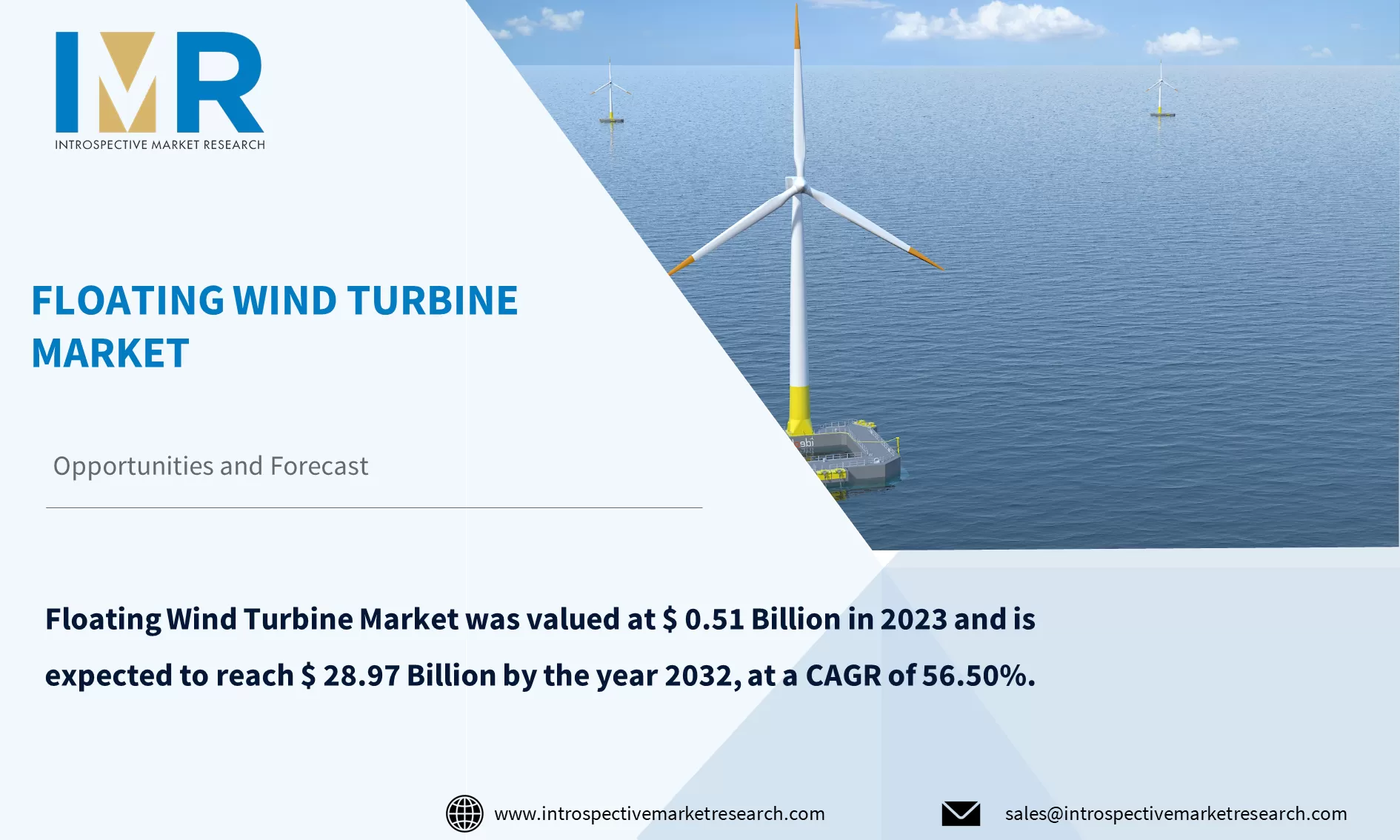
According to a new report published by Introspective Market Research, titled, ?Floating Wind Turbine Market by Type, Processing Method, Application, End-User, and Region Global Market Analysis and Forecast, 2024-2032.
The Global Floating Wind Turbine Market was valued at $ 0.51 Billion in 2023 and is expected to reach $ 28.97 Billion by the year 2032, at a CAGR of 56.50%.
The floating wind turbine market is a sector within the renewable energy industry that focuses on developing, producing, and deploying wind turbines mounted on floating structures rather than fixed to the seabed or land. These innovative turbines utilize advanced engineering techniques to harness wind energy in deeper waters where traditional fixed-bottom turbines are not feasible. They offer advantages such as access to higher wind speeds and less visual impact on coastal landscapes, playing a crucial role in expanding offshore wind energy generation and contributing to the global transition towards sustainable and low-carbon energy sources.
Floating wind turbines are poised to revolutionize offshore wind energy generation, unlocking vast expanses of deep-water regions previously inaccessible to traditional fixed-bottom turbines. This expansion holds profound implications for the global energy landscape, particularly in regions with abundant offshore wind resources but challenging seabed conditions. The escalating threat of climate change underscores the imperative for rapid decarbonization of the energy sector, and floating wind turbines represent a compelling solution for scaling up offshore wind capacity and diversifying the renewable energy mix. Technological advancements have significantly improved the efficiency, reliability, and cost-effectiveness of floating wind systems, making them increasingly competitive with conventional energy sources. Economies of scale and ongoing innovation in turbine design, installation techniques, and floating platform technology are driving down capital and operational costs, further enhancing the attractiveness of floating wind projects.
The floating wind turbine market is poised for exponential growth and transformative impact on the global energy transition, with an ever-expanding pipeline of projects, increasing investment flows, and a growing ecosystem of technology suppliers and service providers.
According to the Floating Wind Turbine, The Market is segmented into Foundation, Capacity, Depth and region. By Foundation, the market is categorized into Spar-buoy Foundation, Tension-leg platform (TLP) Foundation, Semi-submersible Foundation, and Others. By Capacity, the market is categorized into Up to 1 MW, 1-3 MW, 3-5 MW, and above 5MW. By Depth, the market is categorized into Shallow Water and Deep Water. By region, it is analyzed across North America (U.S.; Canada; Mexico), Europe (Germany; U.K.; France; Italy; Russia; Spain, etc.), Asia-Pacific (China; India; Japan; Southeast Asia, etc.), South America (Brazil; Argentina, etc.), Middle East & Africa (Saudi Arabia; South Africa, etc.).
The offshore wind industry is undergoing a significant shift with the increasing adoption of floating wind turbines in deeper waters. Unlike traditional fixed-bottom turbines, floating turbines can be deployed in much deeper waters, sometimes exceeding 100 meters. This technological advancement allows developers to explore new offshore locations previously unsuitable for wind energy development, making regions with strong offshore winds but limited shallow seabed space like the West Coast of the United States, the Mediterranean Sea, and parts of Asia-Pacific viable candidates for large-scale wind farm installations.
The growth of the floating wind turbine market is closely linked to technological advancements. Engineers and developers are continuously refining the design and efficiency of floating platforms to overcome challenges in the marine environment. They are using advanced technologies to enhance stability, cost-effectiveness, and adaptability. This is achieved through iterative design improvements, such as optimized geometries and innovative mooring systems, making these platforms more robust and able to withstand various environmental conditions.
Global Floating Wind Turbine Market, Segmentation
Floating Wind Turbine Market is segmented based on Foundation, Capacity and Depth, and Region.
Depth:
above 5MW segment is expected to dominate the market during the forecast period.
The floating wind turbine market is dominated by turbines with capacities above 5 MW, driven by the increasing demand for energy production efficiency in offshore wind farms. As the global focus shifts towards renewable energy sources, developers and stakeholders are increasingly using higher-capacity turbines to maximize energy yields per unit. Technological innovation is driving this dominance, with manufacturers developing next-generation designs that increase performance and efficiency. These innovations include larger rotor diameters, robust drivetrains, and optimized aerodynamics, aiming to reduce the levelized cost of energy (LCOE) from offshore wind projects. This shift in focus enables stakeholders to unlock unprecedented energy production potential, reduce costs, and accelerate the widespread adoption of offshore wind as a global renewable energy portfolio.
Foundation:
The Semi-submersible Foundation segment held the largest share in 2023. Semi-submersible foundations are the cornerstone of the floating wind turbine market, offering robustness, adaptability, and reliability. They can withstand extreme weather conditions, ensuring uninterrupted energy generation throughout their operational lifespan. These foundations are versatile, offering deployment options in shallow or deep waters, enhancing the scalability of offshore wind farms. They can accommodate larger turbines, reflecting the industry's shift towards higher-capacity systems. This flexibility enables the installation of advanced turbine technologies, increasing efficiency and competitiveness in the offshore wind sector. The dominance of semi-submersible foundations in the floating wind turbine market underscores their crucial role in driving the transition towards sustainable and resilient renewable energy solutions.
Region:
Asia Pacific is Expected to Dominate the Market Over the Forecast Period. The Asia-Pacific region is embracing renewable energy due to environmental concerns and industrialization demands. Countries like Japan, South Korea, and Taiwan are adopting offshore wind as a key energy source. However, traditional fixed-bottom turbines face challenges due to deep waters near their shores. This has led to a shift towards floating wind technology, which can harness wind resources in deeper waters. Government incentives, technological advancements, and partnerships between local governments, industry players, and international developers are driving the growth of the floating wind turbine market. Japan's ambitious plans to increase offshore wind capacity have led to collaborations with European companies, while South Korea's Green New Deal initiative has spurred collaborations with global leaders in floating wind innovation. These partnerships facilitate technology transfer, address financing, regulatory frameworks, and supply chain development. As renewable energy momentum grows, floating wind turbines will play a crucial role in meeting the region's clean energy goals and driving sustainable economic development.
Some of The Leading/Active Market Players Are-
- General Electric
- Vestas
- Siemens
- Goldwind
- Shanghai Electric
- ABB
- Doosan Corporation
- Hitachi Ltd.
- Nordex SE
- EEW Group and Other Active Players
Key Industry Development:
- In January 2024, GE Vernova announced 1.4 GW of onshore wind projects with Squadron Energy in Australia. GE Vernova's Onshore Wind business announced the signing of a strategic framework agreement with Squadron Energy for 1.4 gigawatts (GW) of onshore wind projects in New South Wales, Australia. Squadron Energy announced the agreement earlier this month, marking the commencement of construction of the Uungala Wind Farm.
- In May 2023, GE announced that it would invest $50 million in its Schenectady, NY, facility and hire about 200 additional full-time employees, including skilled union operators, manufacturing engineers, and front-line leadership, to develop a new manufacturing assembly line for its onshore wind business. The facility will assemble three essential components for GE Vernova's 6.1 MW turbine.
Key Findings of the Study
- Turbines with capacities above 5 MW are expected to dominate the market due to their efficiency in offshore wind farms.
- Semi-submersible foundations held the largest market share in 2023 due to their robustness, adaptability, and ability to support larger turbines in various water depths.
- The Asia-Pacific region is anticipated to lead the market growth, driven by countries like Japan, South Korea, and Taiwan adopting floating wind technology to harness offshore wind resources in deeper waters.





